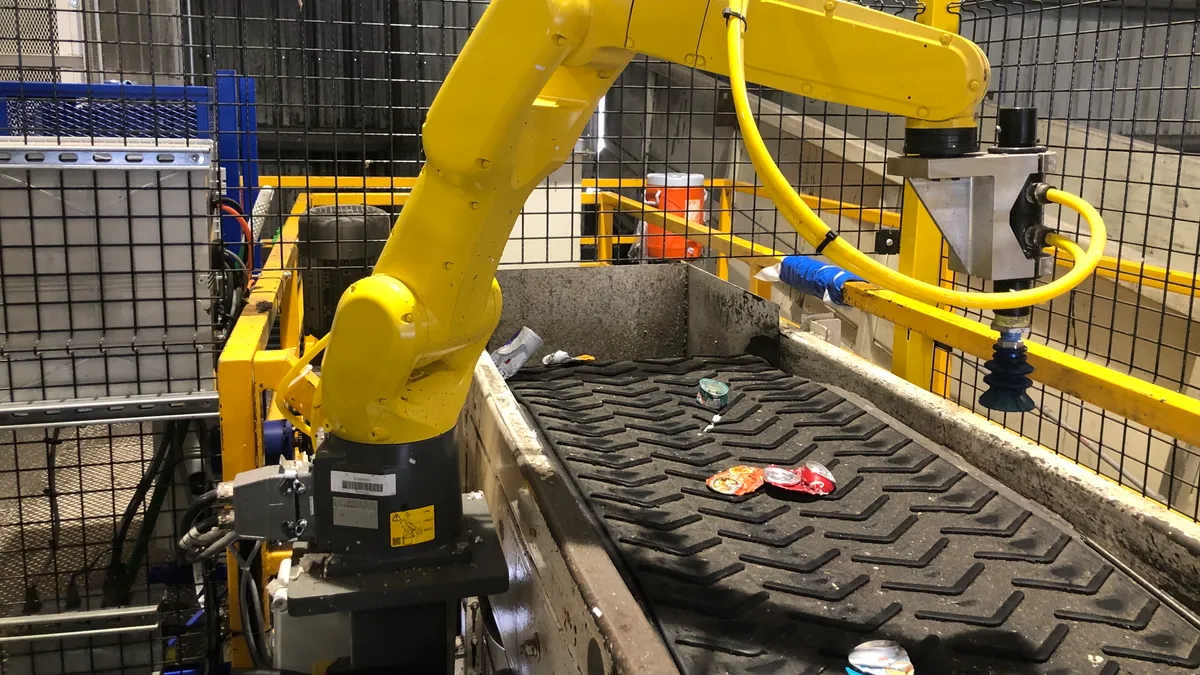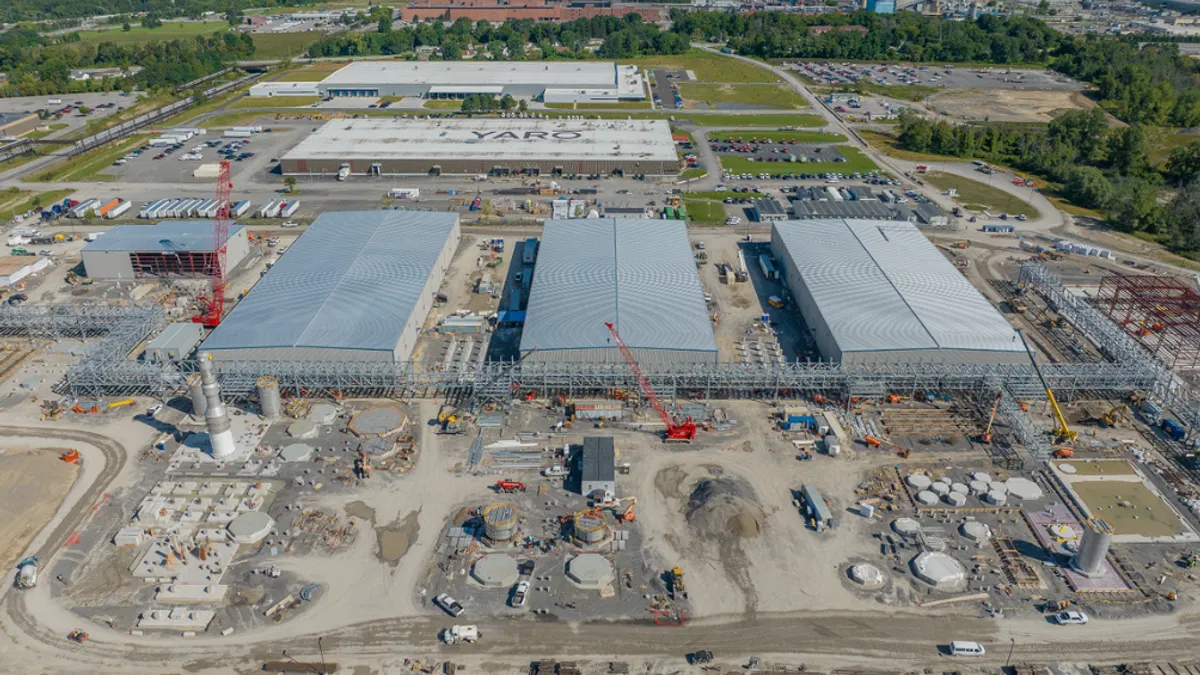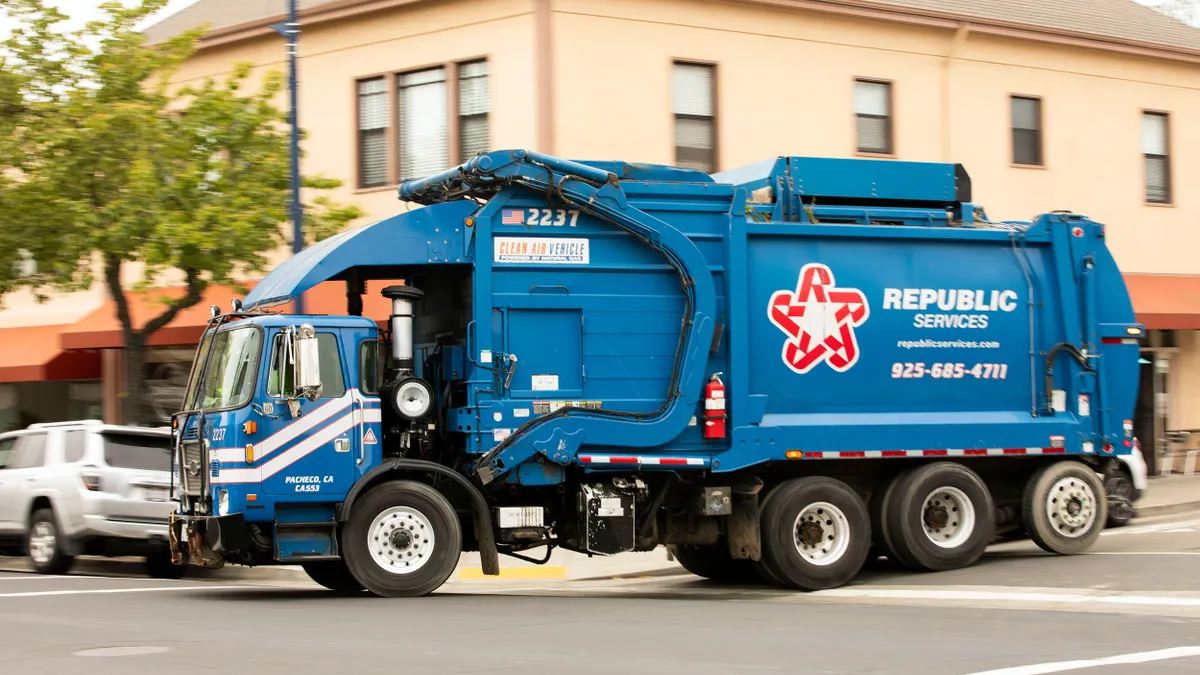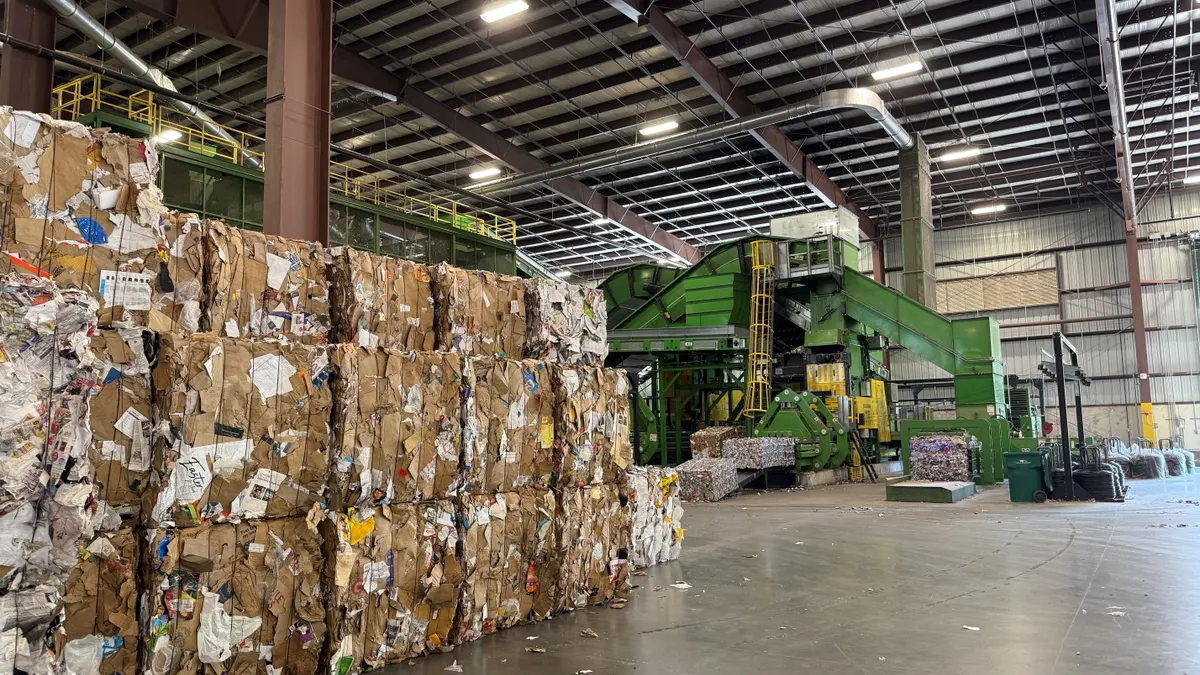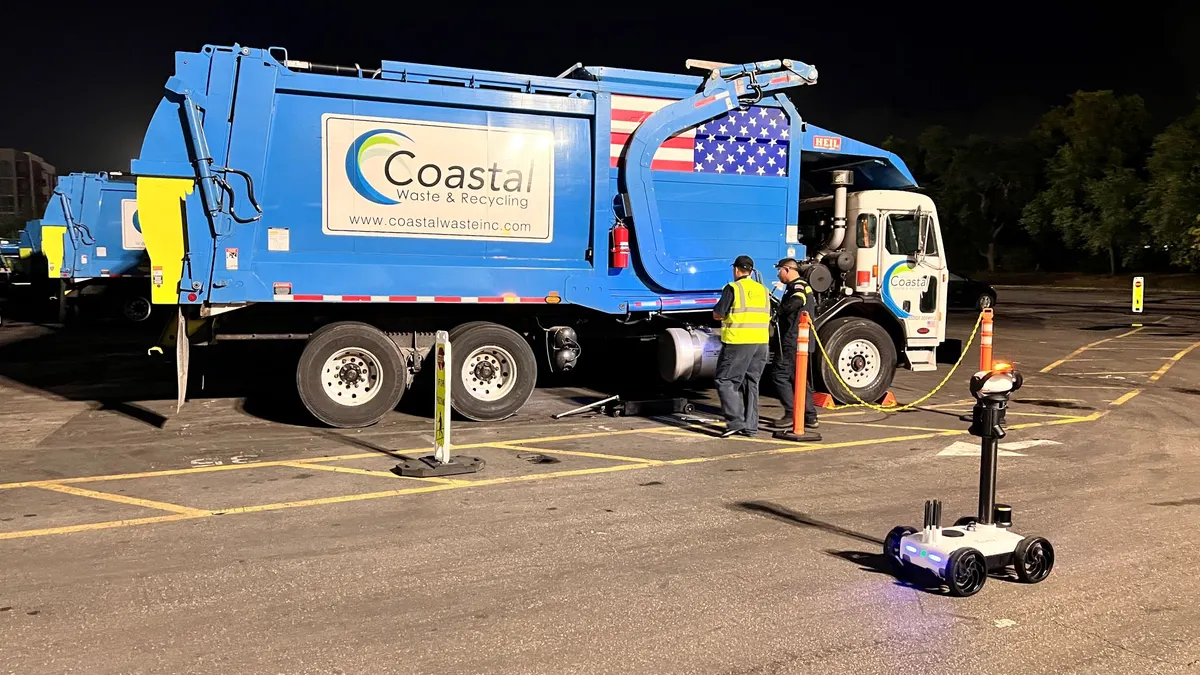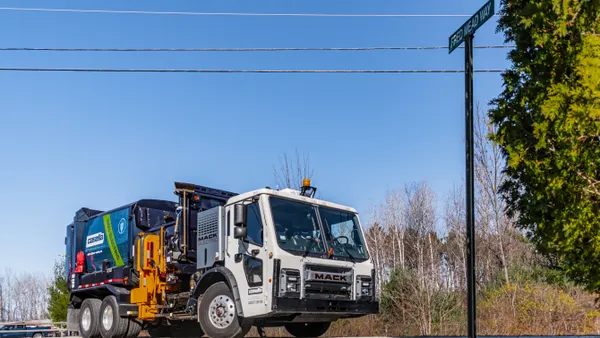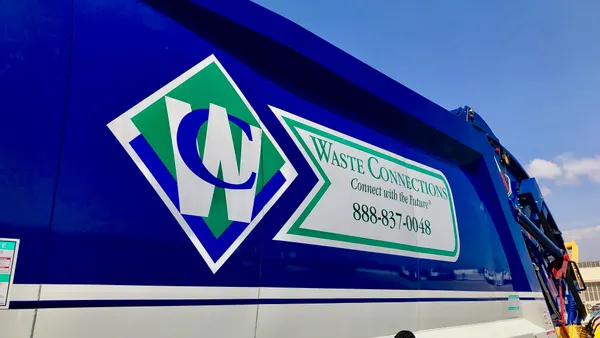As more MRF operators install artificial intelligence-powered systems in their facilities, those that purchase the equipment to improve sortation say the machines are also gathering something that may make them even more valuable: large amounts of data.
AI-driven equipment such as robots went from being a novelty just a few years ago to now being a key part of how MRF operators plan to cut labor costs and create cleaner streams of recyclable commodities. Major waste and recycling companies are regularly reporting robotics investments in earnings calls alongside fleet plans and other capital investments.
“It’s the AI that is really so much more powerful for the MRF environment than just the robots, because the AI gives you insight into everything going on with the MRF,” said Don Gambelin, head of sales and business development at recycling software system and robotics company Everest Labs. “What does the collection system look like? How much contamination is really coming in through the door?”
Granular data on commodities, contamination and the overall makeup of the MRF’s stream is becoming more important than ever, said Jeff Snyder, director of recycling at Rumpke Waste & Recycling. In April, Rumpke installed the first of four new robotics systems manufactured by Machinex, which it will rely on to sort PP and HDPE as a way to invest in expanding domestic markets for these plastics.
Beyond getting more value from those specific streams, Snyder said the potential for AI to report data that could help the MRF run more efficiently “is the future of the quality of recycling.”
Investing in a changing stream
In recent years, more MRFs have been adopting AI-driven robotics at scale by taking advantage of newer models and competitive pricing. In 2019, nearly 100 robots were operating in MRFs and other recycling-related facilities in North America, according to data from Resource Recycling. Facilities have announced dozens more installations since then.
Waste Connections announced in December it would install 24 systems from AMP Robotics in its facilities across the country to capture more material on container, fiber, and residue lines. GFL Environmental, Republic Services, Waste Management and other major MRF operators have also made similar investments. In addition to AMP, other providers of AI-powered robotic sorting systems include Bollegraaf (and its North American distributor, Van Dyk Recycling Solutions), Bulk Handling Systems (BHS), Everest Labs, Machinex, Waste Robotics and ZenRobotics.
Many MRFs, like Rumpke, see AI-powered robotics — as well as other advanced sortation equipment, such as optical sorters — as key tools for capturing more material to sell into changing markets that demand higher-quality product streams. These MRFs are also trying to plan ahead for what they think the recycling stream will look like “at least 10 years down the road,” said Andrea Rodriguez-Piñero, director of engineering at FCC Environmental Services.
During a presentation at WasteExpo Together Online in September, Rodriguez-Piñero described how AI and robots can help “MRFs of the future” adapt to constant material stream changes like the curveballs they’ve already faced during COVID-19, such as a recent influx of plastic packaging and residential cardboard from the “Amazon effect” as more consumers buy items online.
Commodity market changes will also prompt more MRFs to consider investing in robotics, predicted Snyder. “If you said we were going to [use robotics to] pick polypropylene five years ago or three years ago, I wouldn’t have believed that. Nobody was doing that, because we didn't have a market for it,” Snyder said. “As things change, we want to adapt.”
Rumpke's installation was funded in part by a $775,000 grant from The Recycling Partnership, an organization that has given several rounds of grants to companies through its Polypropylene Recycling Coalition. Backing the effort are brands such as Keurig Dr Pepper, Nestlé, Procter & Gamble and the Walmart Foundation. Snyder estimates the new robotics system will help capture between 40 and 100 tons of PP a month, and data it generates from sortation should give the company a better picture of the amount they really collect.
Others have also taken note of increased competition in the recycling robotics space. Closed Loop Partners, a circular economy investment firm, was among the investors that helped AMP Robotics raise $55 million from a number of sources in January.
Closed Loop sees AI and robotics as critical technologies to help the United States achieve a circular economy, Managing Director Bridget Croke told the U.S. Senate’s Environment and Public Works Committee during a June 2020 hearing on recycling challenges.
“The future of the industry will be led by the recycling facilities that produce the highest quality commodity bales of materials,” she said at the time.
Separating the AI from the robots
Though the terms “robotics” and “AI” are sometimes used interchangeably, robotic recycling systems have three main components: First there’s the vision system, which identifies materials on the belt through characteristics like color, shape and size. Then, there’s the robot, which uses that information to physically pick up or sort specific objects based on programming. The system’s third element, and the one that companies like AMP say is the biggest selling point, is its AI-powered “learning capability.”
AI-powered robotics systems like AMP’s and others upload each individual robot’s data to the cloud so other connected robots around the world can learn from that data and improve further. AMP’s AI platform, which it calls Neuron, has a shared object recognition run rate of more than 10 billion items each year, the company says.
With greater competition in the robotics space than in past years, Matanya Horowitz, AMP’s founder and CEO, said he expects more innovations in both robotics hardware and AI that can adapt to more specific MRF needs. “Robotic technology is maturing but not slowing down,” he said.
AI technology also powers other modern systems, like optical sorters, that use jets of air or other methods rather than robotic picking arms to achieve sortation. These systems also have numerous sensors and cameras to analyze material and sort it as effectively as possible, said David Marcouiller, executive vice president of sales engineering for Machinex, at the Southeast Recycling Conference (SERC) in August.
As AI grows more sophisticated, so do optical sorters, which can identify items and gather valuable data with high-resolution or 3D cameras. MRF operators do not see robotics as a replacement for optical sorters, but rather as a teammate that can work in collaboration to achieve cleaner overall output, said Robert Taylor, Republic Services’ area manager for plant operations in Texas, during a panel discussion at the virtual WasteExpo.
A common spot for a robot is on the line just after an optical sorter. “The AI portions of these [robotic] systems are incredibly accurate in identifying targeted materials,” said Taylor, but optical sorters are still the stars when it comes to tackling the “sheer volume” of material coming through the main inbound stream. His MRF’s robot isn’t designed to handle that volume of material, even if it can identify and pick items very quickly.
FCC’s MRF in Houston uses a Bollegraaf robotics system meant to create a higher quality fiber product after material flows through optical and other sorting systems. The robot operates on the mixed paper quality-control line to recover both OCC and prohibitives, like aluminum and PET, Rodriguez-Piñero said. Robots are ideal on this part of the line because “the suction cups tend to capture the fiber a lot better than they do with containers, which all take different forms, whether they're smashed, or they're in their original form,” she said.
Assessing the stream
Before a facility installs a new robotics system, operators should know more about what's flowing through their equipment to make sure it will be a good fit for the necessary tasks and priority materials. The robotics company often will first set up a material characterization process by installing and running the vision system without the robotic arm.
Machinex spent 45 days gathering data on Rumpke’s material stream before installing any hardware, using that time to train the robot’s AI-powered “brain” to see and identify the objects that typically go through the stream so it can perform its job as effectively as possible, according to Snyder. “As all these materials go through the system so many times, identification gets better and better and better on the composition of the material that's coming through," he said.
This initial assessment helps to calibrate the equipment, but both robotics companies and MRFs agree the data they get in the process has applications beyond simply familiarizing a machine with its new job. Many robotics companies offer standalone visual assessment systems or services meant to scrutinize items on the belt and gather additional data to help MRF operators optimize material recovery or fix weaknesses in the sorting line.
Everest will often perform plant performance analytics before even recommending a robot, said Gambelin. This helps collect information that customers will be able to use to make an informed decision about whether robotics are even a good fit for their plant.
Amanda Marrs, senior director of product with AMP Robotics, said one MRF used their material characterization system, called Clarity, to take a deeper look at the makeup of its residual stream over the course of a year. The data showed a significant number of aluminum cans weren’t getting recovered, and the company adjusted its existing equipment and installed a new robot to capture the material.
“That's what this data does, it gives you an indication of where you can adjust your process or a piece of your operation to capture valuable material and increase revenue,” she said during SERC.
Other companies also supply such standalone visioning systems. Recology, a San Francisco-based MRF operator, installed BHS’s Visual Identification System (VIS) in 2019, in addition to four robots. As the robots pick plastic and other materials, the VIS monitors the outbound residue. This gives the MRF operators real-time and trending data on outbound material composition. Recology uses that data to adjust the system “to optimize recovery,” the company said in a news release.
Everest has installed AI-powered robots in four California facilities so far, and another two West Coast plants are using just the AI technology, Gambelin said. AI can help diagnose problems within the larger MRF sorting system, such as worn-down discs on a screen or a mechanical issue, by looking at data outputs that indicate changes in material composition, he said.
FCC uses AI-generated data to inform quality-control decisions “to make sure that our separators are efficient,” and if not, “trigger what needs to be changed in the process so the final product is achieving the percentage of purity that the market is demanding,” Rodriguez-Piñero said.
Characterization data also comes in handy to help prove baled material lives up to its purported quality, Snyder added.
“When you send a bale of paper to a paper mill, for example, and the mill says ‘Well, wait a minute, the quality of your bale is off,’ you can point to the data to prove otherwise,” he said. “That is a really, really cool technology that AI can provide — analysis related to what is truly on your belt at any given point in your source system.”
AI and the future of labor
AI-driven data also adds nuance to the discussion over where robotics fits into the labor force, some MRF operators say. High turnover in sorting jobs that can be dirty and dangerous is an ongoing issue. Many waste and recycling companies struggled to fill sorting roles even before the pandemic began, and the industry has increasingly seen robots as a potential solution.
“We would be kidding ourselves to think that labor is not a continuing problem,” Snyder said, “but we don’t see this as replacing people as much as it is trying to take that burden off certain positions.” One of the robots installed at a Rumpke facility sorts HDPE natural from other colors, a process that used to be done by hand.
Marcouiller of Machinex points out that AI can add value to MRFs that still rely on human sorters because employees are focused on sorting items correctly and can’t report on bigger-picture trends, such as how material streams change over time.
Kate Davenport, co-president of nonprofit Eureka Recycling, said during the Resource Recycling conference in August that MRFs can invest in both technology and employees at the same time. When Eureka's MRF installed robotics, for example, it created a new position for an employee to monitor and interpret robotics data.
Taylor of Republic said he envisions that MRFs of the future could use enhanced AI and robotics technology to automatically adjust equipment based on material changes, thereby taking humans entirely out of the sorting process.
Though Gambelin of Everest thinks total MRF automation could be possible in the future, in the near term, “we have to transition away from the idea that robots are better than humans in every application, because robots work differently than humans,” he said.
Many MRFs were originally designed before robotics and other modern sorting equipment became widely available on the market, meaning some types of retrofits may not work for the layout and design of a given facility, said Gambelin. Data gathered from AI “is really insightful in this instance because it can help set expectations on what [a robot’s] performance will really look like and make sure the customer is happy with that.”
MRF operators and AI and robotics vendors say AI will likely have new applications in the future, possibly by helping sort materials at an even more specific level for emerging markets or niche clients. Everest, AMP and other equipment manufacturers say they can already sort some items by brand or bar code, and AMP recently announced it was using the capability to recover K-cup coffee pods.
A packaging company recently asked Everest for data on how its products flow through different MRFs to get insight on ways to redesign its packaging for better recyclability. “It matters where packaging ends up in the MRF. If a container ends up on paper line, there’s a chance that it won't get recovered,” Gambelin said.
That level of technology could also be used to support extended producer responsibility initiatives by working directly with brands to use AI and robotics to target specific containers, sort them and return them to the brand owner. Gambelin anticipates brand owners could help fund the equipment built to do that.
“My view is that if you can get the manufacturer to contribute directly to a direct activity that actually recovers their material, they'd be far more amenable to doing that,” he said.
MRFs that have already invested in such equipment may also find uses for it they haven’t even thought of yet.
“The inspiring part about these computer systems is their ability to continue to learn constantly — gathering data on color, size, form factors and even brand recognition,” Republic's Taylor said. “It's limitless right now, I think, with AI, what we're going to be able to do in the future here in the MRFs.”



